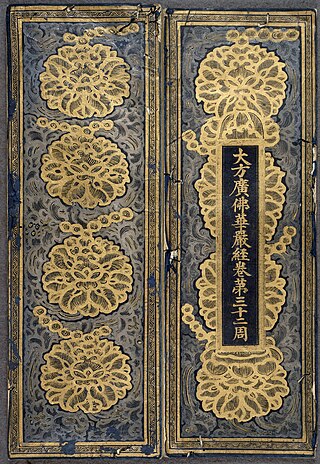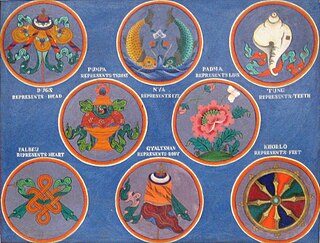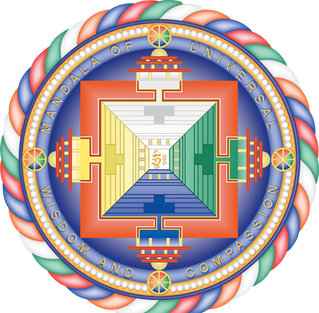Related Research Articles

Tibetan Buddhism is a form of Buddhism practiced in Tibet, Bhutan and Mongolia. It also has a sizable number of adherents in the areas surrounding the Himalayas, including the Indian regions of Ladakh, Sikkim, and Arunachal Pradesh, as well as in Nepal. Smaller groups of practitioners can be found in Central Asia, Xinjiang, Inner Mongolia, and some regions of Russia, such as Tuva, Buryatia, and Kalmykia.

Vajrayāna, also known as Mantrayāna, Mantranāya, Guhyamantrayāna, Tantrayāna, Tantric Buddhism, and Esoteric Buddhism, is a Buddhist tradition of tantric practice that developed in the Indian subcontinent and spread to Tibet, Nepal, other Himalayan states, East Asia, and Mongolia.

Amitābha is the principal Buddha of Pure Land Buddhism. In Vajrayana Buddhism, Amitābha is known for his longevity, discernment, pure perception, and the purification of aggregates with deep awareness of the emptiness of all phenomena. According to some sutras, Amitābha possesses infinite merit resulting from great deeds cultivated across his countless past lives as Dharmākara Bodhisattva. The name Amitābha translates to "infinite light."

Chögyam Trungpa was a Tibetan Buddhist meditation master and holder of both the Kagyu and Nyingma lineages of Tibetan Buddhism.

The Buddhāvataṃsaka-nāma-mahāvaipulya-sūtra is one of the most influential Mahāyāna sutras of East Asian Buddhism. It is often referred to in short as the Avataṃsaka Sūtra. In Classical Sanskrit, avataṃsaka means garland, wreath, or any circular ornament, such as an earring. Thus, the title may be rendered in English as A Garland of Buddhas, Buddha Ornaments, or Buddha’s Garland. In Buddhist Hybrid Sanskrit, the term avataṃsaka means “a great number,” “a multitude,” or “a collection.” This is matched by the Tibetan title of the sutra, which is A Multitude of Buddhas.

Geshe Kelsang Gyatso was a Buddhist monk, meditation teacher, scholar, and author. He was the founder and spiritual director of the New Kadampa Tradition-International Kadampa Buddhist Union (NKT-IKBU), a registered non-profit, modern Buddhist organization that came out of the Gelugpa school/lineage. They have 1,300 centres around the world, including temples, city temples and retreat centres that offer an accessible approach to ancient wisdom.
A Jewish Buddhist is a person with a Jewish background who believes in the tenets of a form of Buddhism.

Surya Das is an American lama in the Tibetan Buddhist tradition. He is a poet, chantmaster, spiritual activist, author of many popular works on Buddhism, meditation teacher and spokesperson for Buddhism in the West. He has long been involved in charitable relief projects in the developing world and in interfaith dialogue.

The Ashtamangala is a sacred suite of Eight Auspicious Signs featured in a number of Indian religions such as Hinduism, Jainism, and Buddhism. The symbols or "symbolic attributes" are yidam and teaching tools. Not only do these attributes point to qualities of enlightened mindstream, but they are the investiture that ornaments these enlightened "qualities". Many cultural enumerations and variations of the Ashtamangala are extant.

Thubten Yeshe (1935–1984) was a Tibetan lama who, while exiled in Nepal, co-founded Kopan Monastery (1969) and the Foundation for the Preservation of the Mahayana Tradition (1975). He followed the Gelug tradition, and was considered unconventional in his teaching style.

The Foundation for the Preservation of the Mahayana Tradition (FPMT) was founded in 1975 by Gelugpa Lamas Thubten Yeshe and Thubten Zopa Rinpoche, who began teaching Tibetan Buddhism to Western students in Nepal. The FPMT has grown to encompass over 138 dharma centers, projects, and services in 34 countries. Lama Yeshe led the organization until his death in 1984, followed by Lama Zopa until his death in 2023. The FPMT is now without a spiritual director; meetings on the organization's structure and future are planned.

Buddhism and Jainism are two Dharmic religions that developed in Magadha (Bihar) and continue to thrive in the modern age. Gautama Buddha and Mahavira are generally accepted as contemporaries. Jainism and Buddhism share many features, terminology and ethical principles, but emphasize them differently. Both are śramaṇa ascetic traditions that believe it is possible to attain liberation from the cycle of rebirths and deaths (samsara) through spiritual and ethical disciplines. They differ in some core doctrines such as those on asceticism, Middle Way versus Anekantavada, and self versus non-self.
Buddhism, also known as Buddha Dharma, and Dharmavinaya, is an Indian religion or philosophical tradition based on teachings attributed to the Buddha. It originated in the eastern Gangetic plain as a śramaṇa–movement in the 5th century BCE, and gradually spread throughout much of Asia via the Silk Road. It is the world's fourth-largest religion, with over 520 million followers (Buddhists) who comprise seven percent of the global population.

Buddhist art is visual art produced in the context of Buddhism. It includes depictions of Gautama Buddha and other Buddhas and bodhisattvas, notable Buddhist figures both historical and mythical, narrative scenes from their lives, mandalas, and physical objects associated with Buddhist practice, such as vajras, bells, stupas and Buddhist temple architecture. Buddhist art originated in the north of the Indian subcontinent, in modern India, Pakistan and Afghanistan, with the earliest survivals dating from a few centuries after the historical life of Siddhartha Gautama from the 6th to 5th century BCE.
Donald Sewell Lopez Jr. is the Arthur E. Link Distinguished university professor of Buddhist and Tibetan Studies at the University of Michigan, in the Department of Asian Languages and Cultures.

Buddhism is an ancient Indian religion, which arose in and around the ancient Kingdom of Magadha, and is based on the teachings of Gautama Buddha who was deemed a "Buddha", although Buddhist doctrine holds that there were other Buddhas before him. Buddhism spread outside of Magadha starting in the Buddha's lifetime.

Women in Buddhism is a topic that can be approached from varied perspectives including those of theology, history, anthropology, and feminism. Topical interests include the theological status of women, the treatment of women in Buddhist societies at home and in public, the history of women in Buddhism, and a comparison of the experiences of women across different forms of Buddhism. As in other religions, the experiences of Buddhist women have varied considerably.
Janice Dean Willis, or Jan Willis is Professor of Religion at Wesleyan University, where she has taught since 1977; and the author of books on Tibetan Buddhism. She has been called influential by Time Magazine, Newsweek, and Ebony Magazine. Aetna Inc.'s 2011 African American History Calendar features professor Willis as one of thirteen distinguished leaders of faith-based health initiatives in the United States.
Buddhist modernism are new movements based on modern era reinterpretations of Buddhism. David McMahan states that modernism in Buddhism is similar to those found in other religions. The sources of influences have variously been an engagement of Buddhist communities and teachers with the new cultures and methodologies such as "Western monotheism; rationalism and scientific naturalism; and Romantic expressivism". The influence of monotheism has been the internalization of Buddhist gods to make it acceptable in modern Western society, while scientific naturalism and romanticism has influenced the emphasis on current life, empirical defense, reason, psychological and health benefits.
Secular Buddhism—sometimes also referred to as agnostic Buddhism, Buddhist agnosticism, ignostic Buddhism, atheistic Buddhism, pragmatic Buddhism, Buddhist atheism, or Buddhist secularism—is a broad term for a form of Buddhism based on humanist, skeptical, and agnostic values, valuing pragmatism and (often) naturalism, eschewing beliefs in the supernatural or paranormal. It can be described as the embrace of Buddhist rituals and philosophy for their secular benefits by people who are atheist or agnostic.
References
- ↑ "GemsTone Audio-Visual Home Page". Gemstone-av.com. Retrieved 8 August 2023.
- ↑ Paine, Jeffery (2003-03-31). Re-enchantment: Tibetan Buddhism Comes to the West. Hardcover. W. W. Norton & Company. p. 288. ISBN 0-393-01968-3. ASIN B000FA4UY2. Jacket quote.
- ↑ "WEB EXCLUSIVE: The Best Books of 2004". PublishersWeekly.com. Retrieved 8 August 2023.
- ↑ "Spirituality & Health Books | Spirituality & Health Magazine". Archived from the original on 2010-03-14. Retrieved 2007-04-10. Best Books, 2004
- ↑ Alfred de Grazia. "The Universal Reference System" (PDF). Archived from the original (PDF) on 2011-07-23. Retrieved 8 August 2023.
- ↑ "The Wilson Quarterly". Archived from the original on 8 May 2007. Retrieved 8 August 2023.
- ↑ "Institute for Citizens & Scholars - Developing Effective, Lifelong Citizens". Institute for Citizens & Scholars. 17 May 2023. Retrieved 8 August 2023.
- ↑ "American Institute of Indian Studies (AIIS)". American Institute of Indian Studies. Retrieved 8 August 2023.
- ↑ "SEO Company - Award-Winning Professional SEO Experts - Digitaleer". Digitaleer.com/. Retrieved 8 August 2023.
- ↑ "East-West Center". Eastwestcenter.org. Retrieved 8 August 2023.
- ↑ "Yaddo – A Retreat For Artists in Saratoga Springs, NY". Yaddo.org. Retrieved 8 August 2023.
- ↑ "MacDowell". MacDowell.org. Retrieved 8 August 2023.
- ↑ "The Bellagio Center : The Rockefeller Foundation". 28 June 2014. Archived from the original on 2014-06-28. Retrieved 8 August 2023.
- ↑ Paine, Jeffery (17 November 1999). Father India. HarpPeren. ISBN 0060931019.
- ↑ Quoted on the book jacket of Father India: Westerners Under the Spell of an Ancient Culture, HarperCollins, December 1999, trade paperback, 324 pages, ISBN 978-0-06-093101-8
- ↑ Paine, Jeffery (17 November 2004). Re-enchantment: Tibetan Buddhism Comes to the West. W. W. Norton & Company. ISBN 0393326268.
- 1 2 Quoted on the book jacket of Re-enchantment: Tibetan Buddhism Comes to the West, W.W.Norton, 2004, hardcover, 288 pages, ISBN 978-0-393-32626-0
- ↑ Paine, Jeffery (17 December 2005). Adventures with the Buddha: A Buddhism Reader. W. W. Norton & Company. ISBN 0393327469.
- ↑ Quoted on the book jacket of Adventures with the Buddha, W.W. Norton, 2005, hardcover, 416 pages, ISBN 978-0-393-32746-5
- ↑ Quoted on the jacket of Enlightenment Town. May, 2018. New World Library ISBN 978-1-60868-574-5
- ↑ Quoted on the jacket of Enlightenment Town. ISBN 978-1-60868-574-5
- ↑ Paine, Ed J. (3 April 2001). The Poetry of Our World: An International Anthology of Contemporary Poetry. Harper Perennial. ISBN 0060951931.
- ↑ Smith, Huston (2009-05-12). Tales of Wonder . Harper Collins. ISBN 978-0061154263.
- ↑ Paine, Jeffrey; Thurman, Robert. Thoughts On Buddahism. ISBN 0660193787.
- ↑ "Bodhisattva". Crestone Films. Retrieved 30 April 2013.
- ↑ "Crazy Wisdom the Movie". Crazy Wisdom the Movie. Retrieved 8 August 2023.
Adapted from the Wikinfo article Jeffery Paine, licensed under the GNU Free Documentation License.